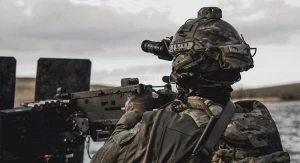
“Old fake under a new guise”. What's wrong with the Washington Post’s article on Nord Stream?
Military-political observer Oleksandr Kovalenko noticed that the article claiming that a Ukrainian officer coordinated the sabotage at the Nord Stream fits well with two Russian narratives
The WP's article echoes Russian narratives
In his article, Oleksandr Kovalenko notes the WP authors assume that the operation to blow up the gas pipeline was supervised by Colonel Roman Chervinsky. He led a group of six people who used aliases to rent a boat and used diving equipment to plant bombs on the pipelines. The authors also claim that Commander-in-Chief of the Ukrainian Armed Forces Valerii Zaluzhnyi was the highest official involved in the operation, while President Volodymyr Zelenskyy was unaware of it.
“In fact, this latest WP story sits like a glove on the two fundamental fake narratives, one of which Russian propaganda masterminds have been developing since 2014, and the other — since 2022. The first one sits on the premise of Ukraine being a “terrorist state”, and the second is about an alleged conflict and competition between Zaluzhnyi and Zelenskyy. It is these old Russian narratives, which we have heard more than once (and debunked more than once), that WP puts out on a silver platter to its audiences and beyond,” Kovalenko concludes.
The journalist also questions the idea that six Ukrainian secret agents were able to carry out an operation to blow up gas pipelines on EU territory, secretly from Western intelligence services, using only a civilian boat and diving equipment, as well as at least one and a half tons of explosives.
“Nothing weird about that, right? After all, you can probably buy explosives at any convenience store in Gdansk… Who knows, maybe they’re even sold in bulk,” Kovalenko writes. “And I’m not even talking about the assumption that the divers planted a 500kg charge some 70 to 80 meters below sea surface. Another piece of cake. Seriously?”
Ukrainian journalist believes that the WP investigation" looks more like conspiracy theories pushed in pursuit of hype.
Old schemes and questionable publications
Kovalenko also recalls similar materials, for example, an article published in May 2023 in the Süddeutsche Zeitung. At that time, he recalls, the publication did not offer any in-depth factual evidence.
The journalist notes that the Nord Stream story reminds him of the investigation into MH17, which was shot down by terrorists over Donbas. The Russians first created a barrage of "investigations" using their own resources, but then, to create the appearance of an "unbiased" view, a number of foreign "journalists" appeared on the scene, picking up the initiative and writing articles that echoed the Russian versions.
One of the leading foreign "investigators" of the MH17 disaster was the Dutch pseudo-journalist Max van der Werff, who simply reposted Russian fakes about the tragedy, accusing Ukraine in front of Western news consumers. Therefore, Kovalenko sees nothing strange in the fact that Russian special services use Western media, information platforms, or individuals as part of their psychological processing.
As for the Süddeutsche Zeitung, the journalist says that he has repeatedly encountered quite controversial materials from this publication.
“In January 2023, it was the Süddeutsche Zeitung published an article claiming that during a phone call between Olaf Scholz and Joe Biden, the German Chancellor allegedly demanded that the United States be the first to provide Abrams tanks to Ukraine, and only after that would Berlin make an appropriate decision on Leopard 2. German government speaker Steffen Heberstreit then denied that claim. Despite this fact, SZ never deleted the piece.
Back in 2021, the Süddeutsche Zeitung published an article, in which it noted that Russia seeks to “accept” the so-called “LPR” and “DPR” into its composition, by the Crimea scenario, while Western nations allegedly have nothing against this and will be persuading Ukraine to agree. This was also an absolutely false claim but SZ never really cared about the facts,” Kovalenko recalls.
Who could have planted explosives at a depth of 70-80 meters below the sea surface?
Returning to the essence of the operation described by WP, Oleksandr Kovalenko emphasizes the statement that the explosives were placed at a depth of 70-80 meters below the sea surface. He refers to the 2019 incident with the unique Russian underwater system AS-12 Losharik, which was probably practicing a scenario of violating the integrity and/or listening to civilian and military underwater communication cables.
“Also, I remember Russia placing elements of their Garmonia underwater surveillance system (similar to U.S.-made SOSUS) and also putting on the seabed devices designed to combat that very SOSUS. The AS-12 could also be practicing the mining of naval infrastructure. Anyway, something went wrong and that submarine is now a thing of the past,” the journalist writes.
He also recalls that in April 2019, Norwegian fishermen in the Finnmark region came across a beluga whale with a harness and a GoPro-type camera attached to it. It is noteworthy that beluga whales are a favorite subject for experiments for the Main Directorate for Deep-Sea Research of the Russian Navy.
“So what I mean is that Russia has every opportunity to carry out this kind of a sophisticated sabotage operation. For example, in 1991, Russian combat swimmers mined a number of Norwegian oil infrastructure facilities. I repeat: they planted bombs on another country’s oil infrastructure!
Therefore, WP journalists, before embarrassing themselves, should at least study the history of the subject a bit harder,” Kovalenko concludes.
- News













































